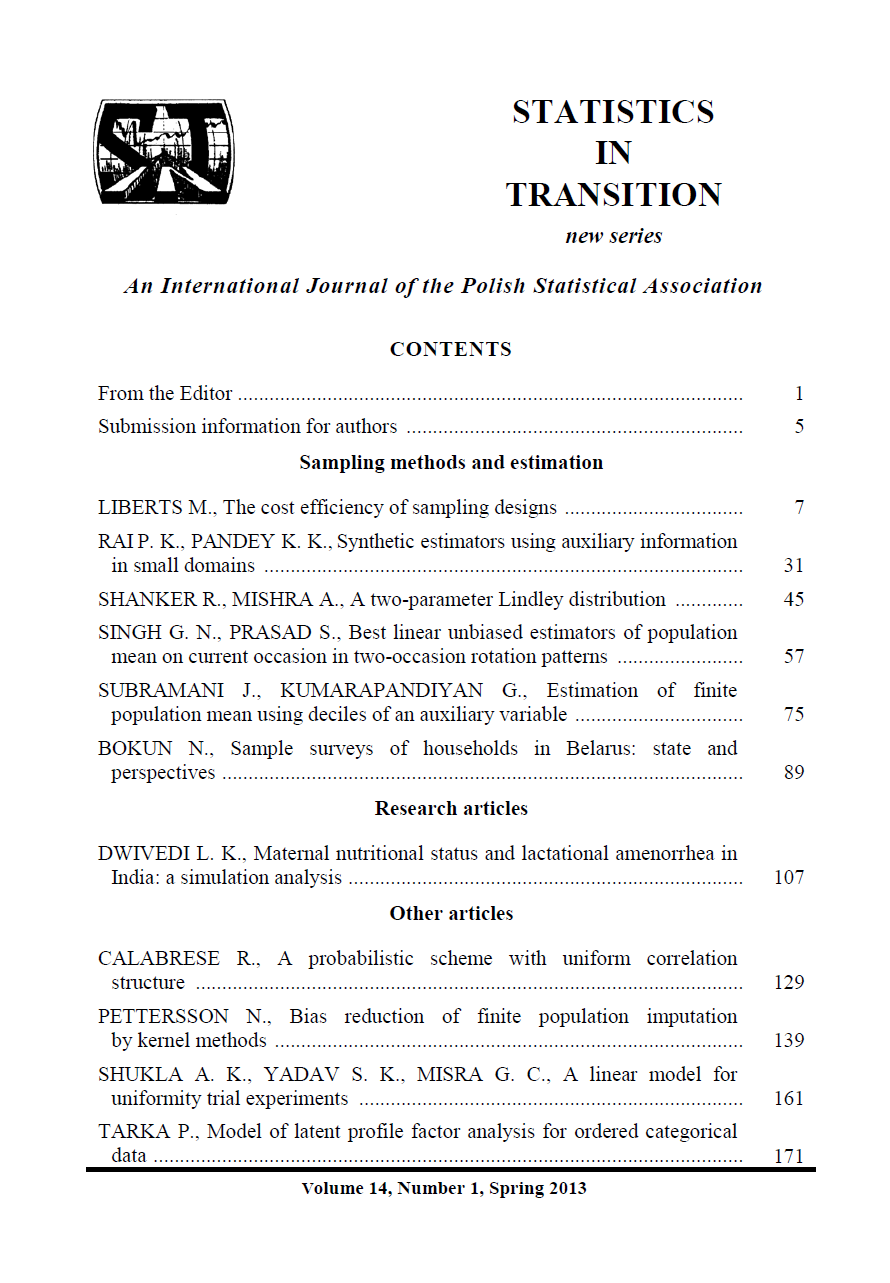ARTICLE
ABSTRACT
The aim of a sample survey is to obtain high quality estimates of population parameters with low cost. The expected precision of estimates and the expected data collection cost are usually unknown making the choice of sampling design a complicated task. Analytical methods can not be used often because of the complexity of the sampling design or data collection process. The aim of this paper is to develop a mathematical framework to compare chosen sampling designs with respect to the expected precision of estimates and the data collection cost. As a result a framework is developed which employs artificial population data generation, survey sampling techniques, survey cost modelling, Monte Carlo simulation experiments and other techniques. The framework is applied to analyse the cost efficiency of the sampling design currently used for the Latvian Labour Force Survey.
KEYWORDS
cost efficiency, simulation study, survey cost estimation, survey methodology, variance of estimators
REFERENCES
Central Statistical Bureau of Latvia., (2012). Employment and unemployment [Metadata]. Riga. Retrieved 15.12.2012, from http://ej.uz/CSB-LFS
CHEN, B.-C., (2008). Stochastic simulation of field operations in surveys (Research report). Washington: U. S. Census Bureau. Retrieved from https://www.census.gov/srd/www/byyear.html
COX, L., (2012). The case for simulation models of federal surveys. In Research conference papers of federal committee on statistical methodology research conference 2012. Washington. Retrieved from http://www.fcsm.gov/events/papers2012.html
European Commission. (2012a). Labour force survey in the EU, candidate and EFTA countries – Main characteristics of national surveys, 2011 (Tech. Rep.). Luxembourg: Eurostat. Retrieved from http://epp.eurostat.ec.europa.eu/
European Commission. (2012b). Quality report of the European Union Labour Force Survey – 2010 (Tech. Rep.). Luxembourg: Eurostat. Retrieved from http://epp.eurostat.ec.europa.eu/
GROVES, R. M., (1989). Survey errors and survey costs. New Jersey: Wiley. HANSEN, M. H., HURWITZ, W. N., & MADOW, W. G., (1953). Sample survey methods and theory (Vol. I). New-York: Wiley.
JESSEN, R. J., (1942). Statistical investigation of a sample survey for obtaining farm facts (Research Bulletin No. 304). Iowa State College of Agriculture and Mechanic Arts. KISH, L. (1965). Survey sampling. New-York: John Wiley & Sons.
LAPINŠ, J., (1997). Sampling surveys in Latvia: Current situation, problems and future development. Statistics in Transition, 3(2), 281–292.
LAPINŠ, J., VASKIS, E., PRIEDE, Z., & BALINA, S., (2002). Household surveys in Latvia. Statistics in Transition, 5(4), 617–641. Retrieved from http://www.stat.gov.pl/pts/15_ENG_HTML.htm
LIBERTS, M., (2010). The redesign of Latvian Labour Force Survey. In M.Carlson, H. Nyquist, & M. Villani (Eds.), Official statistics – methodology and applications in honour of Daniel Thorburn (pp. 193–203). Stockholm, Sweden: Stockholm University. Retrieved from http://officialstatistics.wordpress.com/
LIBERTS, M., (2013). Survey-design-simulation [Online code repository]. Retrieved from https://github.com/djhurio/Survey-Design-Simulation
MAHALANOBIS, P. C., (1940). A sample survey of the acreage under jute in Bengal. Sankhya: The Indian Journal of Statistics, 4(4), 511–530.
R CORE TEAM., (2013). R: A language and environment for statistical computing [Computer software]. Vienna, Austria. Retrieved from http://www.r project.org
ROSENKRANTZ, D., STEARNS, R., & LEWIS, P., II., (1977). An analysis of several heuristics for the traveling salesman problem. SIAM Journal on Computing, 6(3), 563–581.
SÄRNDAL, C.-E., SWENSSON, B., & WRETMAN, J., (1992). Model assisted survey sampling. New-York: Springer.
United Nations. (2010). Handbook on population and housing census editing: Revision 1. New York: United Nations.
WASSERMAN, L.,(2004). All of statistics. New-York: Springer.
